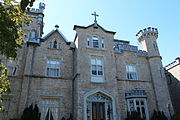Residence Park (New Rochelle, New York)
| Residence Park | |
|---|---|
| Neighborhood | |
 | |
| Country |
|
| State |
|
| County | Westchester |
| City | New Rochelle |
| Time zone | Eastern (UTC-5:00) |
| • Summer (DST) | Eastern (UTC-4:00) |
| Area code(s) | 914 |
Residence Park is a historic community located in the city of New Rochelle, in Westchester County, New York. It holds the distinction of being one of the first planned residential parks, and garden city communities, in the United States. The area is located in the southern section of the city, bordered by Neptune Park on the west, Shore Road and Long Island Sound on the south, and Downtown New Rochelle on the north.
History
Residence Park is situated on the former country estate of the wealthy 19th century New York City hotelier Simeon Leland. Leland purchased 40 acres overlooking New Rochelle Harbor as the site for his country home, eventually commissioning the architect William Thomas Beers to design a gothic revival castle in 1855. The sixty room residence Castleview took three years to complete (1856 -1859) and served as Lelands main residence until his death in 1872. In 1885 the castle and property were purchased by real estate developer Adrian Iselin Jr. who sold off most of the land to create "Residence Park".[1]
Planning
The Garden City Movement arose in England during the 19th century as a reaction to the crowding and pollution of cities as a result of its Industrial Revolution.[2] While the movement had spread to United States by the 1920s, early residential developers had begun experimenting with the 'Garden City' concept way before it gained the title, including Adrian G Iselin, who planned "Residence Park" in 1885. The neighborhood can be viewed as the grandfather to suburban living in the modern American city. Prior to its existence, residential settings were limited to either very rural or very urban design extremes. Lots were fronted by no more than a ditch or a dirt road when not immediately in the urban environment, and when in the city, there was little to no natural space except for public parks.[3] In Residence Park, specific attention to public spaces, natural settings and visual beauty helped distinguish it from most other suburban developments.
When creating the community, Iselin paid considerable attention to the layout and measurements of streets, the parkways, sidewalks, lighting, greenways, parks, and the overall landscape plan of the community. One of his fundamental goals was to create a community that blended in with the natural topography, designed around large garden areas, landscaped islands and traffic medians, and winding streets.[4]
The community had a strict set of conditions, covenants and restrictions that set minimum property costs, controlled what was built and established property setbacks. The residential architecture reflects several distinct styles popular around the turn of the twentieth century such as Queen Anne Style, Colonial Revival and Tudor. The neighborhood is largely intact today as its layout has not been altered, the landscaping of the common areas has matured, and virtually all the original residences remain.[5]
Landmarks, sites and attractions
Several historically significant structures are located within the area including the former country home of the American patriot and Huguenot Lewis Pintard, a National Historic Landmark. The The First Presbyterian Church of New Rochelle is built at the site of the Pintard House, which has been incorporated into the church property as the priory.[6] Pintard founded the Chamber of Commerce of New York and also served General Washington as Commissary for the prisoners in New York City. His son founded the New York Historical Society, served as secretary of the New York Chamber of Commerce, and was elected first Sagamore of the Tammany Society.[7]
The College of New Rochelle is another significant fixture of the neighborhood. The college's campus encompasses much of the former Leland country estate, and includes the original family residence, "Castleview", a National Historic Landmark.[8]
Additional notable sites include the home of baseball legend Lou Gehrig which is located on Meadow Lane.[9]
-
First Presbyterian Church
-
Lewis Pintard House
-
Leland Castle
References
- ↑ Historical and Landmarks Review Board - City of New Rochelle "Application for Nomination as a Local Historic District"
- ↑ The Garden City Movement
- ↑ The Residence Park: Defining the "American Dream", by Michael Borbely
- ↑ New Rochelle, Barbara Davis
- ↑ Historical and Landmarks Review Board - City of New Rochelle "Application for Nomination as a Local Historic District"
- ↑ National Register of Historic Places Nomination - First Presbyterian Church and Lewis Pintard House
- ↑ Encyclopedia of biography of New York: Volume 1
- ↑ Leland Castle; College of New Rochelle. National Register of Historic Places designation report. Washington, DC: U.S. Department of the Interior/National Park Service, 1976
- ↑ "Lou Gehrig: A Biography", Page. 63
See also
- U.S. Geological Survey Geographic Names Information System: Residence Park
- NYHomeTownLocator - Community Profile, Residence Park
- NYHometownLocator - MAP, Residence Park


